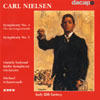Nielsen Symphonies Nos 4 & 5
These performances make some minor additions based on new ‘critical edition’ scores, but are under-characterised overall
View record and artist detailsRecord and Artist Details
Composer or Director: Carl Nielsen
Label: Dacapo
Magazine Review Date: 9/2000
Media Format: CD or Download
Media Runtime: 76
Mastering:
DDD
Catalogue Number: 8 224156

Tracks:
| Composition | Artist Credit |
|---|---|
| Symphony No. 4, '(The) inextinguishable' |
Carl Nielsen, Composer
Carl Nielsen, Composer Danish National Radio Symphony Orchestra Michael Schønwandt, Conductor |
| Symphony No. 5 |
Carl Nielsen, Composer
Carl Nielsen, Composer Danish National Radio Symphony Orchestra Michael Schønwandt, Conductor |
Author: David Fanning
Here is a rather disappointing follow-up to this team’s coupling of Nielsen’s Second and Third Symphonies (12/99). In that issue there were admittedly some questionable aspects to Michael Schonwandt’s conducting, but at least the string tone was full-bodied and the recording had impact, whereas here the impression is curiously bloodless. Not only are the strings thin, in the worst Danish tradition, but the woodwind, with the conspicuous exception of the first clarinet, lack character and are ill-balanced, while the percussion in the first movement of the Fifth Symphony are politely integrated rather than looming threateningly large as the composer specified.
Much of the Fourth Symphony goes reasonably well, until the transition from first to second movement sags, making the ensuing music feel merely episodic. Equally the link to the finale, where the strings’ Leonora 3-like onrush is slightly tentative, renders the succeeding drama ineffectual. Although Nielsen’s warring timpani are admirably clear, overall this registers as at best an interesting, at worst an under- characterised performance.
There are technical problems with some of the playing in the first movement of the Fifth Symphony, and an overall lack of purpose that has to be laid at Schonwandt’s door. He sets a soggy tempo for the second movement, giving it no chance to generate any kind of momentum and hence depriving the unique design of the movement of its raison d’etre. Thereafter the fast fugue is leaden-footed, the slow fugue circumspect and the conclusion merely formal.
By and large Schonwandt follows the new critically edited scores from the Carl Nielsen Edition, quite legitimately departing from them when he sees fit. There is mild interest in some of the scraps he salvages from Nielsen’s draft scores, as listed in the commentaries to that edition. These don’t amount to very much – an extra horn counterpoint at 1'30'' in the finale of The Inextinguishable, a couple of unfamiliar timpani interjections in the second movement of the Fifth – but they are the only thing about this issue that would make me want to return to it.'
Much of the Fourth Symphony goes reasonably well, until the transition from first to second movement sags, making the ensuing music feel merely episodic. Equally the link to the finale, where the strings’ Leonora 3-like onrush is slightly tentative, renders the succeeding drama ineffectual. Although Nielsen’s warring timpani are admirably clear, overall this registers as at best an interesting, at worst an under- characterised performance.
There are technical problems with some of the playing in the first movement of the Fifth Symphony, and an overall lack of purpose that has to be laid at Schonwandt’s door. He sets a soggy tempo for the second movement, giving it no chance to generate any kind of momentum and hence depriving the unique design of the movement of its raison d’etre. Thereafter the fast fugue is leaden-footed, the slow fugue circumspect and the conclusion merely formal.
By and large Schonwandt follows the new critically edited scores from the Carl Nielsen Edition, quite legitimately departing from them when he sees fit. There is mild interest in some of the scraps he salvages from Nielsen’s draft scores, as listed in the commentaries to that edition. These don’t amount to very much – an extra horn counterpoint at 1'30'' in the finale of The Inextinguishable, a couple of unfamiliar timpani interjections in the second movement of the Fifth – but they are the only thing about this issue that would make me want to return to it.'
Discover the world's largest classical music catalogue with Presto Music.

Gramophone Digital Club
- Digital Edition
- Digital Archive
- Reviews Database
- Full website access
From £8.75 / month
Subscribe
Gramophone Full Club
- Print Edition
- Digital Edition
- Digital Archive
- Reviews Database
- Full website access
From £11.00 / month
Subscribe
If you are a library, university or other organisation that would be interested in an institutional subscription to Gramophone please click here for further information.





